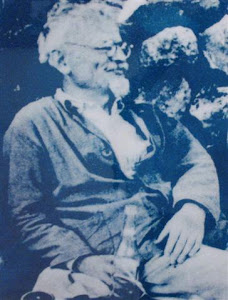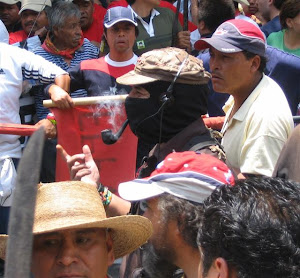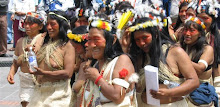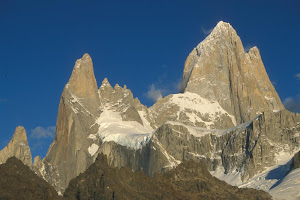








It is highly likely that I would have spent time in México this winter, most likely working for the National Outdoor Leadership School in Baja California Sur as I did last winter. Nevertheless, there is very little possibility that I would have found myself working in Patagonia again this winter (even though colleagues at NOLS had inquired as to my availability) if it had not been for International Rivers approaching me about working as a consultant on their new campaign to protect rivers in the Chilean Patagonia.
Fortunate as I am, I find myself living the best of many worlds in Latin America. The work for International Rivers has enabled me to travel more extensively and incorporate a number of my personal interests into a winters travel that I was slowly motivating myself to organize.
Truly, I am seeing the best of many worlds. I just spent several weeks in México, mostly in Oaxaca and Guerrero, as well as México DF, working from a distance on the preparations for the Pascua Expedition Project for International Rivers through the miracle of the internet, and taking as well a needed break from all work, I repeat, ALL work.
There is nothing quite like time on the beach to get personal batteries fully recharged. It is humorous to contemplate how I have developed some fine beach skills over the last years. After all the time I invested in becoming a competent climber and skier, as far as outdoor activities go I now thrive on sleeping long hours and enjoying a good cold beer with my huevos rancheros and chilaquiles in the late morning hours before whiling away the day reading and swimming in the glorious waves and waters of the Pacific Ocean.
It was a well-needed break, and now I have a full battery charge for the next month of intensive work in Chile’s Aisén Region. I really do feel as well rested as I have in a good long time as I prepare to carry out the expedition that we are attempting. I am quite fired up for taking a good look at the remote and wild Río Pascua, one of the two major waterways threatened by ENDESA and Colbun’s proposal to build giant dams and destroy these free flowing rivers.
Yet before I immerse myself in Patagonia again, I want to share here a couple of highlights that stick out from my memories of the last couple of weeks. My time in Ciudad de Oaxaca was particularly powerful, considering the turmoil that has wracked that city and state in the last years. The repression and violation of human rights that occurred last November especially is very well documented in a publication that I read from extensively during my break from work—La Quinta Visita de la Comisión Civil International de Observación de los Derechos Humanos. A relevant piece of analysis concludes that Brad Will was purposely targeted by state government paramilitaries to force the United States government to come down on the Fox government to send in the Mexican federal police and break the social movement.
Oaxaca is to México a little like Guantánamo is to the United States—that dark side of a conservative power elite that many normal people are afraid to contemplate seriously due to the implications that the violence that has happened in those places means for our societies. How long do we look away?
I had one particularly intense moment in observing a white female tourist, obviously not Mexican, take photos of an old indigenous couple that implored to not have their photo taken. This woman encapsulated to me all the snotty and racist energy that has emanated from gringo tourists bemoaning the conflict in Oaxaca that caused tourism to be placed on a total backburner. While the older indigenous woman grabbed her husband by the arm, slowing his attempt to rise and confront the white woman that ignored their requests to not have their photograph taken, the white lady went ahead and snapped photos, oblivious to their pleas and the brutal rudeness of her own behavior.
It was all I could do to avoid confronting that white woman and tell her that her classist attitude and cultural ignorance encapsulated everything that people might hate about “Americans” from the United States. In that moment I understood why, perhaps in the heat of a mad demonstration that marginalized Oaxaqueños might find themselves unleashing in frustration at the impunity that the power elite enjoy, why there might be an urge to burn to the ground famous tourist icons. In that moment I hated the stupid white people of my country, as well as ignorant rich tourists from all over the world, in a way that I had not felt ever before, more profoundly than I could remember even in my most adolescent punk-rock anti-capitalist tirades.
I managed to walk away from that moment and catch my breath, just in time to let the overwhelming sadness kick in. A sadness knowing that underneath the aesthetic beauty of historical Oaxaca there still exists a sharp tension, a dream deferred, and the scars of political manipulation of a community’s psyche. Death squads and media broadcast death threats are not injuries that heal rapidly.
México is a place of contrasts. The other highlight that I want to mention was being spontaneously invited to participate in a Huichol ceremony a couple of nights before the new year. Estoy muy agradecido a nuestras colegas por habernos invitado estar con ustedes por esta noche tan especial. Estar presentado a las enseñanzas del Maracame de la sierra madre occidental fue un honor. Nunca me olvidaré de la música, el fuego, la ceremonia, y la luz del día que nos llegó después de tanto trabajo en una playa quieta de Guerrero.
Yes, my batteries are recharged, and with clarity I can see the whole of the next steps of work that lie ahead of me. Gracias maestro Maracame! Desde México voy hácia la Patagonia para celebrar sus ríos lindos y vivos!
PS. Tengo fotos de mi llegada a Chile en mi manyhues,gnn.tv blog, veanlas!
.jpg)



.jpg)











.jpg)
.jpg)
.jpg)



No comments:
Post a Comment